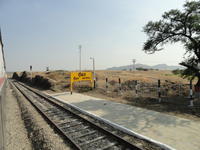|
| Post PNR | Post Blog | Advanced Search |
DNJ/Daundaj (1 PFs)दौंडजदौंडज

Track: Double Electric-Line
दौंडज
दौंडज
Track: Double Electric-Line
Updated: Mar 28 (11:17) by Harsha_12627^~
Indraprastha Rd,Daundaj Gaon - 412305 State: Maharashtra Elevation: 692 m above sea level Type: Regular Category: NSG-6Zone: CR/Central Division: Pune No Recent News for DNJ/Daundaj Nearby Stations in the News | Pune Lohegaon Airport/PNQ: 50 km Number of Platforms: 1 Number of Halting Trains: 2 Number of Originating Trains: 0 Number of Terminating Trains: 0 | 0 Follows Rating: NaN/5 (0 votes) cleanliness - n/a (0) porters/escalators - n/a (0) food - n/a (0) transportation - n/a (0) lodging - n/a (0) railfanning - n/a (0) sightseeing - n/a (0) safety - n/a (0) |
Nearby Stations
JJR/Jejuri 8 km WLH/Valha 8 km NIRA/Nira 19 km RJW/Rajevadi 20 km ABLE/Ambale 25 km LNN/Lonand Junction 26 km TGLN/Taradgaon 33 km SHIV/Shindawane 34 km SLP/Salpa 35 kmStation News
Page# Showing 1 to 3 of 3 News Items
May 10 2021 (15:31) (soil under the railway track was eroded near Daundaj) esakal | काळ आला होता, पण वेळ आली नव्हती! दौंडजजवळ मोठा अनर्थ टळला (www.esakal.com)
News Entry# 451314 Past Edits
Other News
CR/Central
News Entry# 451314 Past Edits
May 10 2021 (15:31)
Station Tag: Daundaj/DNJ added by महाँकाल एक्सप्रेस/1084688
Station Tag: Daundaj/DNJ added by महाँकाल एक्सप्रेस/1084688
Stations: Daundaj/DNJ
Posted by: SmallTownTraveller^~ 5351 news posts
वाल्हे : पुणे-मिरज रेल्वे मार्गाच्या (Railway line) रुंदीकरणाचे काम गेल्या काही वर्षांपासून सुरू आहे. या कामादरम्यान दौंडज रेल्वे स्टेशनजवळ (Daundaj Railway Station) एका ठिकाणी पावसाचे पाणी...
Jul 08 2019 (11:34) When the long whistle blows, trackside is where they’ll be (timesofindia.indiatimes.com)
News Entry# 386224 Past Edits
Other News
CR/Central
News Entry# 386224 Past Edits
Jul 08 2019 (11:34)
Station Tag: Adarki/AKI added by 12649⭐️ KSK ⭐️12650^~/1203948
Jul 08 2019 (11:34)
Station Tag: Daundaj/DNJ added by 12649⭐️ KSK ⭐️12650^~/1203948
Jul 08 2019 (11:34)
Station Tag: Shindawane/SHIV added by 12649⭐️ KSK ⭐️12650^~/1203948
Station Tag: Adarki/AKI added by 12649⭐️ KSK ⭐️12650^~/1203948
Jul 08 2019 (11:34)
Station Tag: Daundaj/DNJ added by 12649⭐️ KSK ⭐️12650^~/1203948
Jul 08 2019 (11:34)
Station Tag: Shindawane/SHIV added by 12649⭐️ KSK ⭐️12650^~/1203948
Posted by: Reva18~ 4104 news posts
As a boy growing up in small-town Amravati, Lalam Mandavkar would encounter trains almost every day as his school was just across the railway lines. What...
Jan 26 2019 (06:41) वळणावरची गोल रेल्वे धावणार सरळ रेषेत (m.lokmat.com)
News Entry# 374848 Past Edits
Other News
CR/Central
News Entry# 374848 Past Edits
Jan 26 2019 (06:41)
Station Tag: Daundaj/DNJ added by Kapil/31285
Jan 26 2019 (06:41)
Station Tag: Adarki/AKI added by Kapil/31285
Station Tag: Daundaj/DNJ added by Kapil/31285
Jan 26 2019 (06:41)
Station Tag: Adarki/AKI added by Kapil/31285
Stations: Daundaj/DNJ Adarki/AKI
Posted by: axn_kapil 31 news posts
आदर्की : मिरज-पुणे लोहमार्गावर ब्रिटिशकालीन मीटर गेज लोहमार्ग बंद झाल्यानंतर स्वातंत्रकाळात ब्रॉडगेज लोहमार्ग सुरू झाला. त्यावेळी आंबळे, शिंदवने, जेजुरी, दौडज, वाल्हे, सालपे, आदर्की, वाठार स्टेशन या...
read more... वळणावरची गोल रेल्वे धावणार सरळ रेषेत
Page# Showing 1 to 3 of 3 News Items

